How Native American tribes are bringing back the bison from brink of extinction
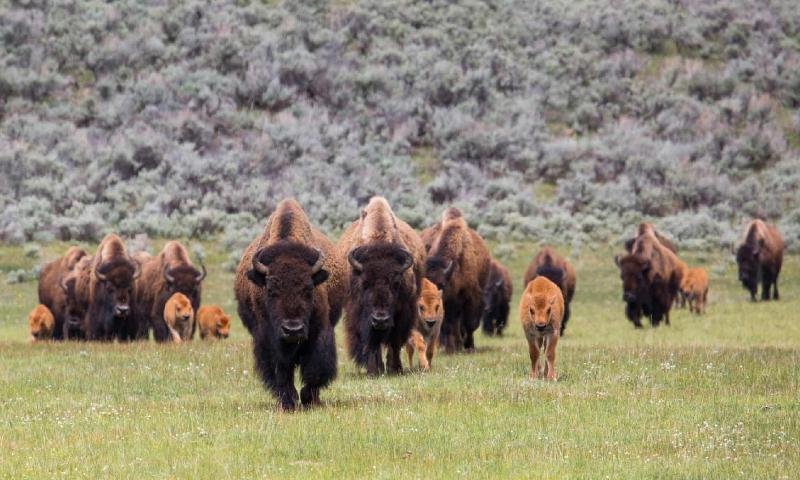

The continent’s largest land mammal plays a crucial role in the spiritual lives of the tribes
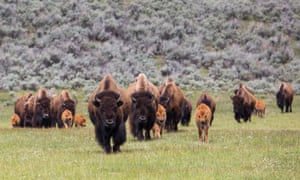
Bison herd with calves in Lamar Valley, Yellowstone Park. Photograph: Neal Herbert/Yellowstone NPS
O n 5,000 hectares of unploughed prairie in north-eastern Montana, hundreds of wild bison roam once again. But this herd is not in a national park or a protected sanctuary – they are on tribal lands. Belonging to the Assiniboine and Sioux tribes of Fort Peck Reservation, the 340 bison is the largest conservation herd in the ongoing bison restoration efforts by North America’s Indigenous people.
The bison – or as Native Americans call them, buffalo – are not just “sustenance,” according to Leroy Little Bear, a professor at the University of Lethbridge and a leader in the bison restoration efforts with the Blood Tribe. The continent’s largest land mammal plays a major role in the spiritual and cultural lives of numerous Native American tribes, an “integrated relationship,” he said.
“If you are Christian and you don’t see any crosses out there, or you don’t have your corner church … there’s no external connection, [no] symbolic iconic notion that strengthens and nurtures those beliefs,” said Little Bear. “So it goes with the buffalo.”
Only a couple of hundred years ago, 20 million to 30 million bison lived in vast thundering herds across North America. They were leftover relics of the Pleistocene and one of the few large mammals to survive the Ice Age extinction.

Bison in the snow Photograph: Neal Herbert/Yellowstone NPS
But less than 400 years after Columbus’ direful voyage, white settlers pushed their way west into Native American territory in so-called manifest destiny. And the US government made the fateful decision to cripple the Native Americans through whatever means necessary. One of these was the bison: the government viewed slaughtering the great herds en-masse as a way to starve and devastate Native American tribes.
Within just decades, the bison went from numbering tens of millions to within a hair’s breadth of extinction. “Fort Peck was the first to stand up and say we want to help. We want to restore these important bison back to their historic Great Plains home,” said Jonathan Proctor, Rockies and Plains program director with NGO Defenders of Wildlife , who has worked with the tribes for years to bring the bison back.
To do so, the tribe looked to Yellowstone’s bison herd. After the slaughter of the 19th century, 23 bison survived in a remote valley in Yellowstone. Today, the herd is 4,000 strong and is seen as a vital population because it has never been domesticated or interbred with cattle, maintaining genetic purity. While so-called pure genetics of the bison are often important to scientists and conservationists, Kelly Stoner – who heads the bison program at the Wildlife Conservation Society – said the issue is more complicated among tribal groups.

Yellowstone National Park Bison Herd grazing as a storm rolls in Photograph: Jacob W Frank/Yellowstone NPS
“You’ll find that amongst Native Americans … the predominant attitude is ‘if it looks like a buffalo and smells like a buffalo, it’s a buffalo’. The deep, personal relationship between Native Americans and buffalo exists, and is relevant and important, whether or not a particular animal has 8% cattle genes or not,” she explained.
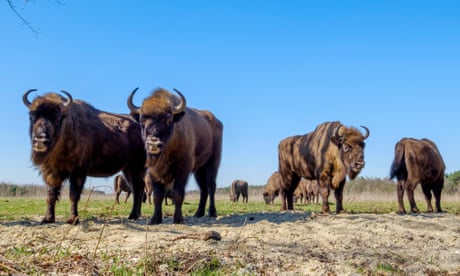
Still, in 2007, Fort Peck Reservation eyed Yellowstone’s herd as a potential source to build a cultural herd. Fort Peck, and many other tribes, already had a commercial herd – used for economic purposes – but now they wanted to build a second herd with conservation in mind.
But getting bison from Yellowstone national park would prove far harder than Fort Peck initially thought. Although pure bred, Yellowstone bison carry the disease brucellosis. The Yellowstone bison originally contracted the disease from cattle in the early 20th century and now ranchers and state officials fear a return. Although scientists have never recorded brucellosis jumping from bison to cattle, it is theoretically possible according to lab research.
“It’s really difficult [to pass]. It’s passed through the placenta,” explained Proctor. “You’d have to have cattle mix with bison in the spring when the bison would potentially abort their calf because of brucellosis and the cattle would have to lick [the aborted placenta]. It’s not likely.”
Still, cattle ranchers so fear the disease that they have pushed for hundreds, sometimes even more than a thousand, bison to be slaughtered every year in Yellowstone national park to keep the animals from roaming outside the park boundaries and potentially mixing with cattle. Yellowstone elk also carry the disease, but are spared slaughter since they are seen as less of a risk.
The brucellosis panic almost stopped Fort Peck from ever getting Yellowstone bison. Over six years, the tribes had to battle anti-bison legislation from the Montana congress and legal battles. The case went all the way to Montana supreme court, which the tribes won unanimously
“The biggest roadblock is the politics in Montana,” said Robert Magnan, director of the Fort Peck tribes’ fish and game department and the buffalo program. “They don’t understand what we’re trying to do out here.”
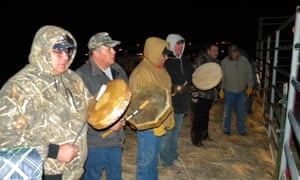
TheTatanke Oyate, Buffalo Nation, Singers from the Fort Peck Reservation in Poplar, Montana, sing a welcoming song for bison arriving from Yellowstone National Park on Monday, March 19, 2012. Sixty-four bison from Yellowstone National Park were shipped to northeast Montana’s Fort Peck Reservation on Monday Photograph: Richard Peterson/AP
The first Yellowstone bison finally arrived in 2012: around 60 animals in all. “There was a huge celebration; many, many people from the community came out,” said Proctor. “It was just thrilling to see.”
Two years after their arrival, Magnan said that the bison had already begun to rejuvenate the land.
“We’ve seen the ecosystem revive. Grassland birds have returned, native grasses are thriving. We welcome and look forward to the buffalos’ continued benefits to our tribal lands.”
Since then, several more deliveries have been made and the Fort Peck herd – at 340 – is among the top 10 conservation herds in the US.
But the work has only begun. In 2014, two years after the bison came to Fort Peck, 13 tribal nations – representing eight reservations both in the US and Canada – signed a ‘Buffalo Treaty’. The treaty outlined the importance of bringing back free-roaming bison to both the US and Canada. “We used to always have an empty chair for the buffalo, for the spirit of the buffalo [at the dialogues], in our talking circles,” said Little Bear, who facilitated the dialogues. “It’s hard to explain but the buffalo was basically asking us, ‘you know, I’ve been gone for 150 years, why do you want me to come back?’”
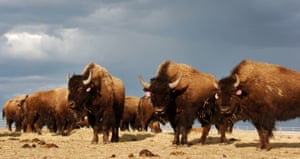
A herd roam on the Fort Peck Reservation near Poplar, Montana Photograph: Matthew Brown/AP
By the end of the dialogues, the tribes agreed why. “The concern was the young people hear only stories, they hear the songs, they see the ceremonies, but they don’t see the buffalo out there,” added Little Bear.

The treaty is already making good. Last year, Blackfeet Reservation, also in Montana, received 89 genetically pure bison from Elk Island in Canada. Although the Blackfeet’s Iinnii Initiative – their name for buffalo – is the youngest, it’s also the most ambitious.
The tribe is negotiating with state officials to allow these bison, which are free of brucellosis, to range freely into Glacier national park and even, hopefully, one day as north as Waterton Lakes national park and Blood Tribe Reservation Canada – which would make it the first international bison herd in over a century.

Tribes sign the treaty to commit to bison repopulation and conservation in Polson, Montana Photograph: Dennis Jorgensen/WWF
Little Bear said they are also working with the Y2Y Initiative , which aims to create a massive wildlife corridor from Yellowstone to the Yukon for wildlife such as bears and wolves.
“We talked to the Y2Y people and said ‘hey, what about buffalo?’ And [they said], ‘we never thought about it but we can include buffalo.’” This year, wild bison returned to Banff national park after being gone over 100 years. Little Bear said the tribe’s Buffalo Treaty acted as a “catalyst” for the re-wilding in Canada’s first park.
“Tribes of the northern plains are the lead in wild bison restoration right now,” Proctor said. In 50 years’ time, the conservation community hopes to have at least 10 bison herds that number 1,000 animals – the minimum, he said, needed for the bison to fulfil their ecological role (currently only Yellowstone has a herd of more than 1,000 animals).
On top of that, Proctor hopes there will be a few herds of more than 10,000 animals, a herd size which hasn’t been seen since the mass extermination in the 19th century.
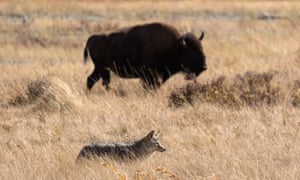
A coyote and bison in Lamar Valley, Yellowstone national park. Photograph: Sumiko Scott/Getty Images
“Well never see bison roaming the entire Great Plains again,” said Proctor. “We’ll never see 20 million to 30 million bison again. No one is trying to go back in time. We’re trying to go forward. We’re trying to restore this important animal where we can, where people want them, and to the level where they will help restore the natural balance.”
For any of this to happen, Native American tribes will be key. They have the land and the desire to bring back the continent’s largest land mammal. And it’s not just bison, Proctor said. They have been instrumental in conserving wolves, grizzly bears, swift foxes and black-footed ferrets among other species.
Magnan said Fort Peck’s “dream” is to have 2,500 buffalo in their conservation herd running on more than 40,000 hectares. Already the tribe has passed a resolution to purchase more land.
“It’s amazing … with limited budgets and widespread poverty, [Native American tribes] are the leader in wildlife restoration when compared to the state wildlife agency,” he said. “In reality, it was not the buffalo that left us, it was us that left the buffalo. So we have to do something.”

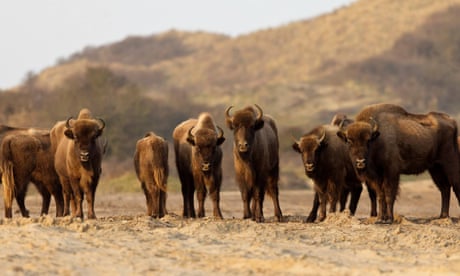



A few years ago the Buffalo was named the official mammal of the US. The Buffalo joins the Bald Eagle as the symbol of America.
If you never had the opportunity to see these magnificent animals live and especially in a herd you have really missed an exciting opportunity.
Riding a horse close to them takes you back in time to when millions roamed the plains of the US and Canada.
NO POLITICS
I had read somewhere that there is a ranch that raises buffalo commercially. They are used the same as beef cattle. Have you heard anything about this?
There are a number of ranches that raise buffalo commercially for food..The meat from buffalo is, IMO, much tastier than beef cattle. It is also much better for you since there is much less fat and no hormones.
The Buffalo being discussed in this article are ''pure'' descendants of the last pure buffalo left in North America. Which mean that they have no cattle DNA in them.
not sure, but I think Ted Turner is still in the buffalo business.
At one point Turner owned the largest herd of buffalo in the US. I'm not sure if that is still true.
A few years ago he sold one of his ranches to the Osage Tribe. It was a very good deal for both parties.
If you ever get to SF, check out a place called Tommy's. They are famous for their buffalo stew. I am glad the descendants are being protected and the numbers rising. It makes me sick that millions of these animals were killed, sometimes shot from moving trains, the meat left to rot.
I haven't been to San Francisco in a decade. Actually lived there for a couple of years in the early 80s.
I had a session with an excellent nutritionist-- among other things she recommended I stopped eating Beef and replace it with Buffalo.
I discovered that some Whole Foods Markets carry it. I tried it-- and I also found it to be much tastier than Beef-- I really like it
And its raised in a natural manner. Since its indigenous to the U.S., the increase of Buffaloes is good for the environment (restoring the natural balance).
I do as well Krishna. At times I'll take buffalo and have the butcher mix in a bit of pork to make sausage...It is really good. Same with venison mixed with pork for sausage.
They did the same to the Indians - not a history to be proud of.
There is a Bison ranch 20 miles away from my place. He sells them whole or cut into any cut you want. Have been to a few BBQs that featured bison. Fairly tasty when cooked/smoked correctly.
Whole Foods has the most delicious buffalo ribs. They are huge and meaty. If you have dogs, they would go nuts for the bones.
I live between 2 small herds. I've witnessed the spiritual connection that Native American have with these creatures. My nephew was at Keystone with a few of his service member brothers standing with the Native Americans when the buffalo stampeded over the ridge during the protest. It was an experience that changed his life to hear him tell it.
Please tell your nephew ''Chi miigwetch'' (many thanks) from the Ojibwe people and from Natives from all tribes.
The appearance of the herd was a moment that many natives will never forget. And I suspect the same for non natives.
according to my nephew, the pinkertons hired by the oil companies lived up to the name pale faces when it happened. it was an electrifying moment in his life.
Chase Iron Eyes just won a lawsuit to have all the correspondence between the private security and the various police agencies...His will really bring some attention to what happened in ND.
Your nephew hit the nail on the head.
without the intervention of cooler NA heads, it almost became 2 burial grounds, one not so ancient. the trench was already dug.
That is true devangelical.
lucky for him and his airborne friends. they went there willing to rock and roll with the rest of the vets that were there. a potential national media disaster for the administration and it's big oil owners.
There were a couple of thousand vets there. It would have been a disaster for the administration and the oil people if it went to physical confrontation.
big oil rent-a-cops and local yokel law enforcement clowns were outnumbered and outgunned and they knew it
I've been there and seen them a few times. It truly is breathtaking. The PNW tribes are hands down bringing back the native salmon runs too.
Fist bump! As our songwriter poet Robbie Robertson said, "I'm rootin' for the Skins!"
Thank you for this wonderful story, Kavika. I had read some time ago about the effort of Native Americans to restore the Buffalo herds to the Great Plains area, but, the information was not as detailed or extensive as this article.
For Native Americans the Buffalo are not only a means to feed the body, but, for feeding the Soul, and nourishing and helping the ecosystem thrive wherever they are.
Thank you for sharing this great story with us.
Exactly RW.
Thank you for such a good and informative article Kavika.
I must admit, one particular, maybe out of the way paragraph grabbed my attention.
Who lived along side those 20 to 30 million bison for for over 10K years?
Who did NOT slaughter them into oblivion?
Curious questions.
Yet, we are often told, Clovis man et al, killed off all the other mega fauna.
I don't think so.
I think the record has a lot of unanswered questions in the area of the mega fauna extinction.
Now we are able to ask question based on evidence.
As quickly as we are learning new things about our past, these days, I am looking forward to a closer answer to the demise of the North American mega fauna.
We know for a fact that the US government slaughtered the Buffalo by the millions to defeat the Indians of the plains.
This is a photo from the 1870s of thousands of buffalo skulls killed by the US Army.
So shameful !
Thank you for a great article.
Years ago in Yellowstone one came down the road, right past my car. What a magnificent animal.
That photo is horrible Kavika. I do not even want to imagine how many hundreds of thousands of Buffalo that mountain of skulls represents.
Look at the men there. They are so proud of themselves.
It is so good to see the work now that is bringing the heards back.
they get chased around by motorcycle morons outside sturgis. sometimes it doesn't work out so well for the riders. tough shit
Not hard to imagine.
i can barely look at that.
Yeah, and one of Teddy Roosevelt's good buds, Buffalo Bill Cody was "supposed" to have killed over 1,500 himself.
Agree. Them standing on their trophy makes it more the worse.
Along side are the bones of our ancestors as well. Truly heartwrenching reality.
Your welcome, happy that you enjoyed the article, pat.
When you're up close to one they are truly magnificent.
Being a plowboy and growing up around live stock I have a appreciation for big animals. Buffalo are one hell of a animal...they nudged me out of the way easier than a 2,000 pound Holstein steer ever did.
Buffalo are great at nudging.
Fab article, Kav. We would see several small herds when traveling to the cabin in Colorado every summer, but they were pretty far away and we never got a good look at them. There was an area between Creede and Lake City where the herds were a little bigger and a little closer. At the time, there was a national park program that concentrated on increasing herd size. It was very exciting to see them up close. They were also a little intimidating size-wise.
During that same time, there was another program that was working to increase the big horn sheep populations in the higher elevations. I still remember seeing my very first in-the-wild big horn sheep. They were exciting to see, but rather ho-hum when compared to the bison.
Without a doubt, they can be intimidating. 2000 lbs that can run at 35 MPH and turn on a dime. Every year in Yellowstone idiot tourists walk up to them a try to photo or pet them...Most never try it a second time.
The bighorn sheep are pretty impressive as well but next to a buffalo not so much.
heart worm almost decimated the big horns a few decades ago. there are signs along I-70 at georgetown warning drivers not to stop to gaze at them perched on the cliffs opposite the town.
I wasn't aware of the heartworm problem with the bighorn. When I lived in NV from 2003 to 2012 the bighorn were plentiful..In fact, in Boulder City, they would come down from the Black Mountains and invade the local parks and eat the grass.
Here is a photo of them in downtown Boulder City.
it may have been unique to rocky mountain bighorn sheep
There used to be a herd of buffalo on a farm near Harrisonburg, VA, beside I-81, but they are not there now. They were a treat to see when you drove by
there's a herd of over 100 buffalo on a wildlife preserve just east of the airport. I've driven by it thousands of times and seen a total of 3 grazing, all large males. hard to spot, even on the 13 mile driving tour. watching the bald eagles and red tail hawks chow down on the prairie dogs is much more common and fun to watch. the hawks dine in picnic style, while the eagles prefer take out dinner for one. those eagles are fucking huge.
When I was stationed at Kirtland AFB, going to and fro to Las Cruces to see the family, I'd drive by the Isleta Pueblo and many times see their herd of buffalo - 'bout 50 - right next to the interstate. Folks would stop their cars and take pics, but the closest a person could get was "maybe" 500 yards. Huge critters.
Picnic style and take out dinner for one...Too funny!
There is a herd of buffalo (100) at Camp Pendleton in CA. I was lucky enough to get a glimpse one time during a field exercise there.
When I was stationed at the Naval Hospital at Camp Pendelton in the early 80's, I would go trout fishing up in the mountains at Casey Springs on base. Frequently managed to see bison roaming around by the lake. They are indeed majestic looking creatures. Even more so seeing them up close in the wild.
Aren't they amazing animals?
This is one of my favorite painting of a buffalo.
This painting is by Robert Bateman and is entitled ''Chief''.
There are two other herds of buffalo that are being "enlarged" through conservation efforts to the North of us - Canada and Alaska. They are the Wood Buffalo and are considered to be pure, with no diseases from domestic animals, i.e. cattle.
What a fantastic opportunity.
The Woodland Buffalo is about 10% larger than the plains buffalo.
Amazing creatures.
The herd in the Wood Preserve are pure and if I remember correctly were discovered in the 1950's...Until then they were thought to be extinct.
I "think" the story is that they found 11 and were stunned, 'cause they too thought they were extinct.
Story going around also 'bout a small herd of Woodlands Buffalo were found on the Eastern seaboard in the Maryland area.
Gonna hafta do more research on that one.
I hadn't heard that. What a hell of a discovery that would be.
Great article Kavika. I had no idea that Indians were so involved in reviving the Buffalo.
Here is a question. They said that at one point that there were only 23 buffalo left. Did they have to bring in those Buffalo from Canada to keep the herd healthy?
To the best of my knowledge, no they did not. The ''pure'' Canadian woodland buffalo was discovered after the herd in Yellowstone.
I used to enjoy Buffalo wings, but they must have been from very little buffaloes. So if pigs could fly, why couldn't buffalo as well?
I think the very first time I saw a buffalo, it was on an American nickle.
Seriously, Kavika, thanks for yet another interesting and educational article.
Your welcome, Buzz.
Dear Brother Kavika: Sorry I am late to this excellent article.
Sunday and Monday were Rosh Ha Shanah.
Busy time for my tribes.
We have been to parks and farms where Buffalo are raised, or roam free here in Upstate NY and rural PA.
At the Wooden Nickel Buffalo Farm a fellow Newsviner and I would start off our days when I was in his neck of the woods going to that farm as the sun rose.
With owners permission, we would stand at the fence with produce for the animals to munch.
The first day or two they would stare at use and study us.
By the second or third day they would inch closer cautiously.
As they got used to us, they would gladly let us feed them.
Majestic animals these.
Delighted to hear of the good work our Indigenous American brothers and sister are doing in the USA and Canada to bring them back into the wild.
Let the Bison play their part as once they did so well in keeping North American eco systems healthy and balanced.
We just need to take care for their well being to keep them away from Bovines at weekend keggers.
The article addresses this danger.
Enoch, Out Grazing Before the Fast of Yom Kippur.